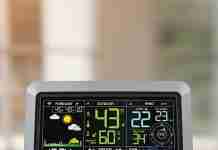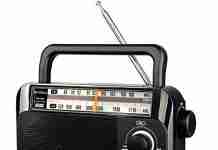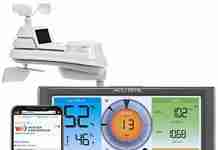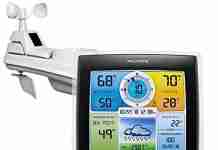Are you curious about the different transmission options available for home weather station data? Look no further! In this article, we will explore the various ways in which weather information can be transmitted from your personal weather station to your computer or mobile device. Whether you’re a weather enthusiast or a homeowner looking to keep track of local conditions, understanding these transmission options will help you make an informed decision on which one suits your needs best. So, let’s dive into the world of home weather station data transmission!
Review contents
Wired Transmission Options
Ethernet
Ethernet is a popular wired transmission option for home weather station data. It provides a reliable and stable connection between the weather station and the receiving device, such as a computer or a router. With Ethernet, data can be transmitted at high speeds, ensuring timely and accurate updates. This is particularly useful for real-time monitoring and analysis of weather conditions. The Ethernet connection can be established through a wired connection using an Ethernet cable, which allows for seamless transmission of data over a local network.
USB
USB (Universal Serial Bus) is another commonly used wired transmission option for home weather station data. It allows for the connection of various devices, including weather stations, to a computer or other compatible devices. USB provides a convenient and straightforward way to transfer data between devices, making it suitable for home weather stations. By connecting the weather station to a computer via USB, users can easily access and analyze the collected weather data. USB connections also support faster data transfer rates than some other wired options, ensuring efficient transmission of weather station data.
Serial Port
While not as commonly used as Ethernet or USB, the serial port is still a viable wired transmission option for home weather station data. Serial ports allow for the transfer of data in a sequence, bit by bit, between devices. Weather stations equipped with serial ports can be connected to a computer or other compatible devices using a serial cable. The serial port offers a simple and reliable means of data transmission, although it may not support as high data transfer rates as Ethernet or USB. Nonetheless, it remains a feasible option for those seeking a wired connection for their home weather station.
Powerline Networking
Powerline networking is a wired transmission option that utilizes existing electrical wiring in a home to transmit data. This technology allows for the creation of a home network without the need for additional Ethernet or USB cables. Powerline networking adapters are connected to power outlets in different rooms, effectively turning the electrical wiring into a network infrastructure. By connecting the weather station to a powerline networking adapter, users can transmit weather data across different rooms without the need for dedicated cables. This option is particularly useful in situations where running Ethernet or USB cables is impractical or inconvenient.
Wireless Transmission Options
Wi-Fi
Wi-Fi is perhaps the most popular wireless transmission option for home weather station data. It allows for seamless and convenient connectivity between the weather station and other devices, such as computers, smartphones, or tablets. By connecting the weather station to a Wi-Fi network, users can access and monitor weather data wirelessly from any connected device within range. Wi-Fi offers excellent range and can support high data transfer rates, ensuring timely updates and accurate analysis of weather conditions. This wireless option is widely adopted due to its flexibility and ease of use.
Bluetooth
Bluetooth is a wireless transmission option commonly used for short-range connections between devices. While it may not offer the same range as Wi-Fi, Bluetooth is still a viable option for transmitting home weather station data within close proximity. By connecting the weather station and a receiving device, such as a smartphone or computer, via Bluetooth, users can access and monitor weather data without the need for a Wi-Fi network. Bluetooth offers simplicity and ease of use, making it an attractive choice for individuals who prefer a wire-free solution for their home weather station.
Zigbee
Zigbee is a wireless transmission option designed specifically for low-power devices, such as home weather stations. It operates on a low-frequency band, allowing for long ranges and low power consumption. Zigbee uses a mesh network topology, enabling devices to communicate with each other and extend the range of the network. By connecting the weather station to a Zigbee network, users can transmit weather data to a central hub or gateway, which can then be accessed and analyzed by various devices. Zigbee offers reliable and efficient data transmission, making it suitable for home weather station setups.
Z-Wave
Z-Wave is another wireless transmission option commonly used for home automation and monitoring systems, including weather stations. It operates on a low-frequency band, providing good range and low power consumption. Z-Wave devices form a mesh network, allowing for seamless communication between devices within the network. By connecting the weather station to a Z-Wave network, users can transmit weather data to a central controller or hub, which can then be accessed and monitored remotely. Z-Wave offers reliable and encrypted data transmission, ensuring the privacy and security of the transmitted weather data.
RF (Radio Frequency)
RF, or Radio Frequency, transmission is a wireless option that utilizes radio waves to transfer data. It is commonly used for remote monitoring and control applications, including home weather stations. RF transmission provides good range and can penetrate through walls and other obstructions, making it suitable for transmitting weather data from an outdoor weather station to an indoor receiver. By connecting the weather station to an RF receiver, users can access and analyze weather data from a central location without the need for direct physical connections. RF transmission offers reliable and robust data transfer, ensuring the timely and accurate retrieval of weather information.
IR (Infrared)
Infrared, or IR, is a wireless transmission option that utilizes infrared light to transmit data between devices. While not commonly used for home weather station data transmission, IR can still be a viable option for short-range communication. IR is typically used in remote controls and other consumer electronics. By connecting the weather station to an IR receiver, users can receive and analyze weather data within the direct line of sight of the weather station. However, it is important to note that IR transmission requires a clear line of sight between the weather station and the receiver, limiting its practicality and suitability for most home weather station setups.
Cellular Transmission Options
2G
2G, or second-generation, cellular networks offer basic data connectivity for transmitting home weather station data over cellular networks. While relatively slower compared to newer generations, 2G networks still provide sufficient bandwidth to transmit weather data in a timely manner. By connecting the weather station to a 2G cellular network, users can access and monitor weather data remotely, even in areas where wired or Wi-Fi connections might be limited. 2G technology is widely available and compatible with older weather station models, making it a suitable option for those who require remote weather monitoring.
3G
3G, or third-generation, cellular networks offer faster data transfer rates compared to 2G networks, enabling more efficient transmission of home weather station data. With 3G connectivity, weather data can be transmitted and accessed in near real-time, allowing for accurate and timely updates on weather conditions. 3G networks offer broader coverage and improved reliability compared to 2G, making them a more suitable choice for remote weather monitoring. By connecting the weather station to a 3G cellular network, users can access weather data from virtually anywhere with cellular coverage.
4G
4G, or fourth-generation, cellular networks provide even faster data transfer rates and improved performance compared to previous generations. With 4G connectivity, home weather station data can be transmitted and accessed with minimal latency, ensuring near real-time updates on weather conditions. 4G networks offer improved coverage and capacity, making them highly reliable for remote weather monitoring. By connecting the weather station to a 4G cellular network, users can access and analyze weather data with ease, even in areas where wired or Wi-Fi connections are not available or practical.
5G
5G, the latest generation of cellular networks, promises significant improvements in data transfer rates, latency, and capacity compared to previous generations. While 5G networks are still being rolled out globally, they hold great potential for transmitting home weather station data with unmatched speed and reliability. 5G technology enables ultra-low latency and supports massive device connectivity, making it suitable for a wide range of applications, including remote weather monitoring. By connecting the weather station to a 5G network, users can access and analyze weather data in near real-time, facilitating accurate and timely weather updates.
Satellite Transmission Options
Geostationary Satellites
Geostationary satellites offer a reliable means of transmitting home weather station data over long distances. These satellites are positioned in a fixed point over the Earth’s equator, maintaining their relative position to the Earth’s surface. By connecting the weather station to a geostationary satellite, users can transmit weather data to a ground station or a satellite antenna, which then relays the data to users or meteorological organizations. Geostationary satellites provide extensive coverage and are suitable for transmitting weather data from remote or inaccessible locations where terrestrial connections may not be feasible.
Polar Orbiting Satellites
Polar orbiting satellites, as the name suggests, orbit the Earth’s poles on a north-south trajectory. These satellites provide comprehensive global coverage and are commonly used for weather monitoring and data collection. By connecting the weather station to a polar orbiting satellite, users can transmit weather data directly to the satellite, which then relays the data back to Earth. Polar orbiting satellites offer high-resolution imaging capabilities, allowing for detailed analysis of weather conditions. They are particularly useful for capturing and transmitting real-time images and data for meteorological research and forecasting purposes.
LoRa (Long Range) Transmission
LoRa, or Long Range, is a wireless transmission option specifically designed for long-range communication with low-power consumption. It operates on the sub-gigahertz frequency band, providing an extended range of transmission compared to other wireless technologies. LoRa is often used in applications such as Internet of Things (IoT) devices, including home weather stations. By connecting the weather station to a LoRa network, users can transmit weather data over long distances without the need for high-power consumption. LoRa technology offers reliable and efficient data transmission, making it suitable for remote or inaccessible weather monitoring locations.
LoRaWAN (Long Range Wide Area Network) Transmission
LoRaWAN, or Long Range Wide Area Network, is a protocol built on top of LoRa technology that enables secure and efficient long-range communication between LoRa devices and a central server. It allows for the scalability and interoperability of LoRa devices, making it suitable for large-scale deployments, including home weather station networks. By connecting the weather station to a LoRaWAN network, users can transmit weather data to a central server or gateway, which can then be accessed and analyzed remotely. LoRaWAN offers low-cost and low-power consumption, ensuring efficient and sustainable transmission of weather data.
NB-IoT (Narrowband Internet of Things) Transmission
NB-IoT, or Narrowband Internet of Things, is a cellular communication standard specifically designed for low-power, wide-area IoT applications. It operates on licensed mobile network spectrums, providing reliable connectivity and deep penetration into buildings and other structures. NB-IoT is suitable for transmitting home weather station data over cellular networks, offering extended coverage and optimized power consumption. By connecting the weather station to an NB-IoT network, users can access and analyze weather data remotely, leveraging the extensive coverage and reliability of cellular networks.
Sigfox Transmission
Sigfox is a Low Power Wide Area Network (LPWAN) technology designed specifically for Internet of Things (IoT) devices, including home weather stations. Sigfox operates on the unlicensed ISM frequency band and provides low-cost, low-power, and long-range wireless connectivity. By connecting the weather station to the Sigfox network, users can transmit weather data to a Sigfox base station, which then relays the data to the cloud. Sigfox offers excellent coverage and is suitable for remote or low-power weather monitoring applications. It provides a cost-effective and energy-efficient solution for transmitting weather data without the need for dedicated cellular or Wi-Fi connections.
Radio Telemetry
Radio telemetry is a wireless communication method that allows for the remote measurement and collection of data using radio waves. It involves the use of a transmitter on the weather station that sends data to a receiver located elsewhere. The receiver can be connected to a computer or other devices to access and analyze the transmitted weather data. Radio telemetry offers flexibility and can operate over long distances, making it suitable for remote weather monitoring applications. By using radio telemetry, weather station data can be collected and transmitted wirelessly, enabling real-time weather updates and analysis.
Offline Data Storage
SD Card
SD (Secure Digital) cards provide a convenient and portable way to store home weather station data offline. These small memory cards can be inserted into the weather station, allowing for the direct storage of weather data. SD cards come in various storage capacities, ranging from a few gigabytes to several terabytes, providing ample space for storing weather data over extended periods. By using an SD card, users can easily transfer weather data to a computer or other devices for analysis at their convenience. SD cards offer a reliable and easily accessible offline data storage option for home weather station users.
USB Flash Drive
USB flash drives, also known as thumb drives or memory sticks, offer a portable and versatile offline data storage solution for home weather station data. These compact devices can be connected to the weather station to store collected weather data. USB flash drives come in a range of storage capacities, allowing for the storage of large amounts of weather data. By using a USB flash drive, users can easily transfer weather data to a computer or other compatible devices for analysis and archiving. USB flash drives provide a convenient and easily accessible option for offline data storage, suitable for home weather station enthusiasts.



































